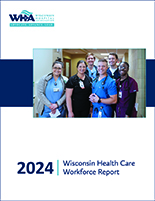
Heightened demand and shrinking supply meant continued high vacancy rates for hospitals in 2023, according to WHA’s
2024 Health Care Workforce Report.
Increasing pressure on the state’s health care workforce driven by retirements within health care fields at the same time demand for health care by an aging population is rising—a trend referred to as the “Silver Tsunami”—has long been cited in WHA’s annual Wisconsin Health Care Workforce Report as a cause for concern as the state seeks to maximize worker availability, longevity and success within the industry.
WHA’s 20th annual report finds the health care workforce vacancy rates that skyrocketed between 2021 and 2022 are stabilizing, but still critical, in 2023. With vacancy rates for 8 of 18 health care professions still in double digits, and growth in Wisconsin’s nursing workforce lagging behind the growth needed to meet current and future demand, the report emphasizes the need to promote interest in health professions, make sure classroom seats are available and expand career pathway options to grow Wisconsin’s health care workforce.
The 2024 WHA Workforce Report highlights the clearly defined, accessible and satisfying career pathways that provide health care a much-needed advantage over other industries. In February 2024, WHA and the WHA Foundation launched a digital media campaign and a hospital career exploration website,
So Many Options, to share the wide range of work and career opportunities hospitals and health systems can provide.
“Wisconsin hospitals are working hard to grow, recruit, retain and support the health care workforce necessary to sustain the high-quality health care Wisconsin citizens expect and deserve,” said WHA Senior Vice President of Workforce and Clinical Practice Ann Zenk. “But even with intense effort, it is unlikely that the health care workforce can grow fast enough to meet the rising health care demand of an aging population.”
The report points to U.S. Census Bureau data that places Wisconsin among the 15 oldest states in the nation. By 2030, one in five Americans will be at retirement age. In Wisconsin, it’s closer to one in four. Those over the age of 65 make up less than 20% of the population but account for nearly 40% of health care utilization. Conversely, those younger than 35 make up 44% of the population but account for just over 20% of health care demand.
The last of the baby boom generation turns 65 in 2030, and while the surge of retirements will subside for other industries, the Silver Tsunami’s impact on health care demand and the health care workforce will persist for decades to come.
“The aging of our population is a demographic force that is largely immovable,” the report notes, “but other gaps can and must be corrected.” Among the gaps identified in the report is increased workforce demand created by systemic breakdowns in the continuum of care, such as nursing home bottlenecks that continue to leave hundreds of community members under the care of hospital teams because a post-acute care placement is not available.
WHA also highlights research that shows a workforce increasingly frustrated and pulled away from patients to meet regulatory demand. A 2024 update to a study that found physicians “tethered to the EHR” notes providers are “even more tethered.” Time spent in electronic health records grew 20% for primary care physicians in just three years.
“Addressing health care workforce shortages will require a concerted effort and sustainable immediate, mid-range and long-term solutions,” said WHA President and CEO Eric Borgerding. “Health care organizations, educators, state regulators and elected officials must continue partnering to minimize outdated barriers and implement innovations to encourage, support and advance health care workers in their pursuit of fulfilling attainable and meaningful careers.”
As the state’s health care industry seeks to attract new workers and build new capacity from within, it must also adapt to the expectations of a multi-generational workforce, WHA notes, and asks for the partnership of policymakers, educators, employers and health care professionals to:
- Create, expand and support educational and occupational pathways to attract new entrants to in-demand frontline technical and clinical positions in the health care workforce.
- Break down barriers to entering and remaining in the health care workforce, including legal, regulatory and payer barriers, burden and burnout.
- Identify practice, policy and payment reforms to allow health care professionals and teams to reach their full potential.
- Support the use of technology for the benefit of patients and the health care workforce.
Read WHA’s 2024 Workforce Report here.